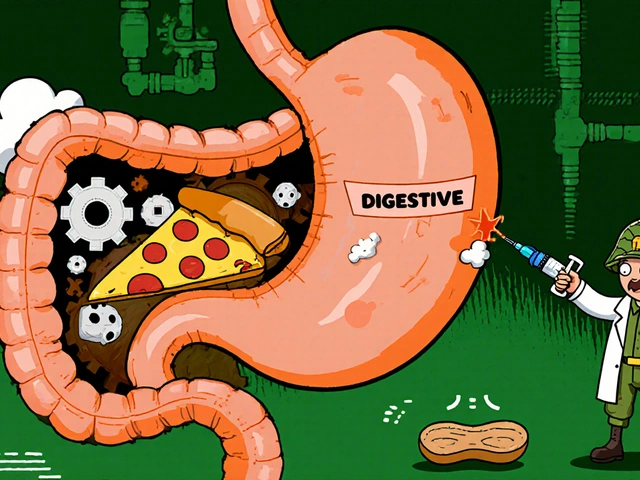Pain Reliever Selection Guide
Find Your Best Pain Reliever
Answer a few questions to determine the most appropriate pain reliever for your situation.
This tool helps you identify the most appropriate pain reliever based on your specific medical conditions and pain characteristics. The recommendations are based on information from the article.
Important: This is for informational purposes only. Always consult your healthcare provider before starting or changing any medication.
Your Recommendation
Based on your answers, the most appropriate pain reliever for you is:
Quick Takeaways
- Naprosyn (naproxen) is a prescription NSAID with a long half‑life, good for chronic inflammation.
- Ibuprofen and aspirin are widely available OTC options but act faster and wear off sooner.
- Celecoxib is a COX‑2‑selective NSAID that lowers stomach‑risk but may affect heart health.
- Acetaminophen isn’t an NSAID; it eases pain without anti‑inflammatory effects, making it safe for many stomach‑sensitive users.
- Choosing the right drug depends on pain type, duration, stomach tolerance, and cardiovascular risk.
What is Naprosyn?
Naprosyn is the brand name for naproxen, a non‑steroidal anti‑inflammatory drug (NSAID) that reduces pain, fever, and swelling by blocking cyclooxygenase enzymes (COX‑1 and COX‑2). It’s typically prescribed for arthritis, tendinitis, and other chronic inflammatory conditions because its half‑life (about 12‑17hours) lets you dose twice daily instead of every 4‑6hours.

How Naprosyn Works
Naproxen inhibits the COX enzymes that convert arachidonic acid into prostaglandins-chemical messengers that cause pain and inflammation. By cutting prostaglandin production, naproxen lowers the body’s inflammatory response, easing joint stiffness and soreness.
Because naproxen stays in the bloodstream longer than many over‑the‑counter (OTC) NSAIDs, it provides steadier pain control. However, the prolonged exposure also raises the chance of gastrointestinal (GI) irritation, especially if taken without food.
Popular Alternatives
When you search for Naproxen alternatives, a few drugs usually appear. Below are the most common choices, each with its own strengths and drawbacks.
Ibuprofen is an OTC NSAID that works quickly, often within 30minutes, but its effects wear off after 4‑6hours, requiring more frequent dosing.
Aspirin (acetylsalicylic acid) is both an analgesic and a blood‑thinner. It’s useful for cardiovascular prevention but can irritate the stomach lining if taken in higher doses for pain.
Celecoxib is a prescription, COX‑2‑selective NSAID. By sparing COX‑1, it reduces GI risk compared with naproxen, yet it carries a modest increase in heart‑attack risk for certain patients.
Acetaminophen (paracetamol) isn’t an NSAID; it relieves pain and fever without anti‑inflammatory action, making it a stomach‑friendly option for mild to moderate aches.
Diclofenac is a potent NSAID often used for acute musculoskeletal pain. It’s available as a topical gel, which can limit systemic side effects.
Meloxicam is another prescription NSAID with a longer half‑life (15‑20hours). It’s frequently prescribed for osteoarthritis and rheumatoid arthritis, similar to naproxen, but may be better tolerated in some patients.
Side‑by‑Side Comparison
| Drug | Prescription / OTC | Typical Dose | Onset (minutes) | Half‑life (hours) | Main Side Effects | Best For |
|---|---|---|---|---|---|---|
| Naprosyn (naproxen) | Prescription | 250‑500mg twice daily | ~60 | 12‑17 | Stomach upset, increased bleeding risk | Chronic inflammatory conditions |
| Ibuprofen | OTC | 200‑400mg every 4‑6h | 30‑45 | 2‑4 | GI irritation, kidney strain | Short‑term pain, fever |
| Aspirin | OTC | 81‑325mg daily (low‑dose) or 500‑1000mg for pain | 45‑60 | 3‑6 | Bleeding, stomach ulcers | Cardiovascular protection, mild pain |
| Celecoxib | Prescription | 100‑200mg once daily | ~60 | 11‑12 | Heart‑risk, mild GI upset | Patients needing GI‑friendly NSAID |
| Acetaminophen | OTC | 500‑1000mg every 4‑6h | 30‑45 | 2‑3 | Liver toxicity (high dose) | Fever, mild‑moderate pain without inflammation |
| Diclofenac (gel) | OTC (topical) | Apply 2‑4g to affected area 3‑4times daily | ~30 (local) | Systemic 1‑2 (minimal) | Skin irritation, rare systemic GI effects | Localized joint or muscle pain |
| Meloxicam | Prescription | 7.5‑15mg once daily | ~60 | 15‑20 | GI upset, cardiovascular risk (dose‑dependent) | Long‑term arthritis management |
How to Choose the Right Option
- Identify the pain type. If inflammation is a major factor (e.g., rheumatoid arthritis), a true NSAID like naproxen, ibuprofen, or meloxicam is usually best.
- Check how long you need relief. For daily, chronic control, naproxen or meloxicam’s long half‑life reduces dosing frequency. For occasional headaches, acetaminophen or ibuprofen works fine.
- Consider stomach sensitivity. If you’ve had ulcers or GI bleed, avoid non‑selective NSAIDs. Celecoxib or topical diclofenac can be kinder to the stomach.
- Review cardiovascular health. Patients with heart disease should steer clear of high‑dose celecoxib or diclofenac and discuss alternatives with a doctor.
- Look at drug interactions. Naproxen can boost the effect of anticoagulants (warfarin, DOACs). Ibuprofen may reduce the efficacy of certain antihypertensives. Acetaminophen is safer with blood thinners but must stay under 3g/day.
Talk to your pharmacist or primary‑care provider with this checklist - it saves time and helps you avoid trial‑and‑error.
Safety Tips & Common Interactions
- Take any NSAID with food or a full glass of milk to protect the stomach lining.
- Avoid alcohol while using naproxen, ibuprofen, or diclofenac; combined they increase GI bleed risk.
- People with kidney disease should limit NSAID use; opt for acetaminophen when appropriate.
- If you’re on blood‑pressure meds (ACE inhibitors, ARBs, diuretics), monitor for reduced efficacy when adding ibuprofen or naproxen.
- Never exceed the maximum daily dose printed on the label or prescribed by a clinician.
Frequently Asked Questions
Can I switch from Naprosyn to an OTC NSAID without a doctor?
Occasionally you can, but only if your pain is mild and you have no history of stomach ulcers or heart disease. It’s safest to get a quick check‑in with a clinician to ensure the new dose won’t cause hidden side effects.
Why does naproxen last longer than ibuprofen?
Naproxen’s chemical structure makes it bind tightly to the COX enzymes and stay in the bloodstream for 12‑17hours, whereas ibuprofen dissociates faster, giving it a half‑life of just 2‑4hours.
Is celecoxib safer for my stomach than naproxen?
Celecoxib selectively inhibits COX‑2, sparing the COX‑1 enzyme that protects the stomach lining. Studies show a lower rate of ulcer formation, but the drug can still raise cardiovascular risk, so it isn’t a universal “safe” pick.
Can I take naproxen together with acetaminophen?
Yes, stacking a non‑opioid NSAID with acetaminophen is a common strategy for stronger pain relief without increasing NSAID dose. Keep each within its recommended daily limit and watch for liver warnings on acetaminophen.
What should I do if I develop stomach pain while on naproxen?
Stop the medication and contact your healthcare provider right away. They may switch you to a COX‑2‑selective NSAID or suggest a protective proton‑pump inhibitor (PPI) alongside the drug.







Comments
Suzi Dronzek
October 12, 2025 AT 18:23 PMI have read countless articles on NSAIDs and can say without hesitation that most of them are riddled with half‑baked advice.
The author’s attempt to portray Naprosyn as a panacea for chronic inflammation is a textbook example of marketing masquerading as medical guidance.
First, the piece glosses over the fact that naproxen’s prolonged COX inhibition significantly increases the risk of gastrointestinal bleeds, especially in patients over sixty.
Second, it fails to stress that the drug’s interaction with anticoagulants is not a trivial footnote but a potentially fatal synergy.
Third, the comparison to ibuprofen is shallow, ignoring that ibuprofen’s shorter half‑life allows for quicker dose adjustments in the event of adverse effects.
Moreover, the author neglects to mention the availability of gastro‑protective agents such as proton pump inhibitors, which should be standard co‑therapy for high‑risk individuals.
The article also omits the socioeconomic dimension; many patients cannot afford a prescription NSAID and must rely on OTC options.
In addition, the suggestion that celecoxib is “riskier” for the heart lacks nuance, as recent meta‑analyses show comparable cardiovascular profiles when used at the lowest effective dose.
The piece’s tone implies that “one size fits all,” which is a dangerous simplification for a drug class with such diverse safety profiles.
Readers deserve a more balanced discussion that includes renal considerations, especially for those with hypertension.
The safety of naproxen in patients with chronic kidney disease is not addressed, despite its known propensity to reduce renal perfusion during dehydration.
The lack of emphasis on lifestyle modifications, such as weight management and physiotherapy, makes the article feel like a mere product catalog.
If the intent was to empower patients, the author should have provided a decision‑making algorithm that integrates comorbidities, not just a checklist.
In short, the article is an instructive case of how not to write patient‑centered medical content.
I urge readers to consult their healthcare providers and not to rely on a single webpage for therapeutic decisions.
Aakash Jadhav
October 18, 2025 AT 13:16 PMAh, the eternal dance of pain and pills, my friends!
We stand at the crossroads of chemistry and suffering, wondering which elixir will soothe our mortal woes.
Naprosyn, they say, is the steadfast knight, lingering long in the battlefield of inflammation.
Yet, what of the fleeting sparks of ibuprofen, the quick‑draw artists of analgesia?
Life, much like pharmacology, is a series of choices weighed against the shadows of side effects.
One must ask: is the comfort of a twice‑daily dose worth the gamble with the gastric gauntlet?
Perhaps the answer lies not in a single tablet, but in the philosophy of listening to one’s own body.
When the storm of pain subsides, may your decisions be as wise as the sages of old.
Amanda Seech
October 24, 2025 AT 08:09 AMI think the guide is really helpful lol.
It makes it easier to pick the right med for you.
But make sure you talk to a doc before you start any new medicine.
Also dont forget to read the warnings about stomach and heart risks.
Hope this helps anyone confused.
Lisa Collie
October 30, 2025 AT 03:03 AMWhile the checklist approach seems user‑friendly, it undeniably reduces complex pharmacodynamics to a series of binary choices, which is a gross oversimplification.
Real patients present with overlapping comorbidities that cannot be neatly compartmentalized.
Moreover, the insinuation that “just follow the tool” dismisses the nuanced clinical judgement required for safe prescribing.
One must remain skeptical of any algorithm that pretends to substitute for a physician’s expertise.
Avinash Sinha
November 4, 2025 AT 21:56 PMWhoa, the table is like a rainbow of options!
Naprosyn feels like the seasoned veteran, hanging around longer, while ibuprofen is the flash‑in‑the‑pan hero.
And celecoxib? That’s the shiny armor for those with delicate tummies but a subtle heart‑tug warning.
Choosing feels like picking a character in a game-each has its own powers and quirks!
Just remember to level up with a doctor’s advice.
ADAMA ZAMPOU
November 10, 2025 AT 16:49 PMEsteemed colleagues, the intricate balance between analgesic efficacy and systemic risk warrants a scrupulous appraisal.
One must deliberate upon the pharmacokinetic profile of naproxen, noting its prolonged half‑life as both virtue and vice.
In the same vein, the cardinal principle of “primum non nocere” should guide the selection of any anti‑inflammatory agent.
Thus, a methodical evaluation of comorbid conditions, concomitant pharmacotherapy, and patient preferences remains paramount.
May this discourse illuminate the path toward judicious therapeutic decisions.
Liam McDonald
November 16, 2025 AT 11:43 AMThank you for the thorough breakdown
It really helps to see the pros and cons laid out clearly
Patients often feel overwhelmed by the medical jargon
Having a concise summary makes the decision process more manageable
Always good to double‑check with your healthcare provider before starting any new med
Adam Khan
November 22, 2025 AT 06:36 AMFrom a pharmacological standpoint, the article’s omission of dosing nuances is egregious; naproxen’s standard 250‑500 mg BID regimen must be contextualized within renal function parameters, as the drug’s plasma clearance is inversely proportional to glomerular filtration rate.
Furthermore, the text fails to address the potential for CYP2C9-mediated drug–drug interactions, particularly when co‑administered with angiotensin‑converting enzyme inhibitors, which may exacerbate hyperkalemia.
Such oversights undermine the academic rigor expected of a medical exposition.
rishabh ostwal
November 28, 2025 AT 01:29 AMWhile I respect the exhaustive nature of the prior commentary, I must advocate for a more stringent moral calculus when prescribing NSAIDs.
It is ethically indefensible to prioritize symptomatic relief over the latent specter of cardiovascular jeopardy, especially in patients with established risk factors.
Consequently, a hierarchy that elevates COX‑2‑selective agents, despite their own perils, must be calibrated against the principle of beneficence.
Clinicians should err on the side of caution, lest they become inadvertent perpetrators of iatrogenic harm.